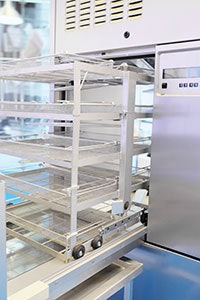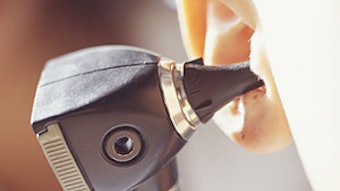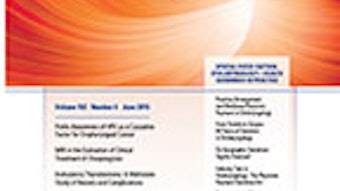FROM THE MEDICAL DEVICES AND DRUGS COMMITTEEThe reprocessing of devices so designatedExpanded from the print edition
Reprocessing of medical devices is an important—and largely transparent—part of an otolaryngologist’s practice. Whether it is in the office setting or operating theater, reprocessing of durable devices is essential to our ability to deliver safe, effective care. This has been in evolution and under scrutiny recently.
By Sven-Olrik Streubel, MD, Children’s Hospital Colorado, Aurora, CO, with Anand K. Devaiah, MD, Chair and Series Editor, Boston University School of Medicine and Boston Medical Center

The ECRI (formerly the Emergency Care Research Institute) ranks inadequate reprocessing of flexible endoscopes and surgical instruments as No. 4 of the top 10 health technology hazards of 2015.1 Of the 13 immediate threat to life (ITL) discoveries from Joint Commission surveys conducted in 2013, seven were directly related to the improper sterilization or high-level disinfection of equipment.2 The Joint Commission takes ITLs seriously. If discovered during a survey, the organization immediately receives a preliminary denial of accreditation (PDA) and, within 72 hours, must either entirely eliminate the ITL or implement emergency interventions to abate the risk to patients (with a maximum of 23 days to totally eliminate the ITL). Corrective actions may include: reprocessing of all equipment or instruments involved in the infection control breach; evaluating staff competency and conducting training; and implementing an equipment tracking process that traces items used back to the patient, in the event of an infection control breach or recall.
According to reports to The Joint Commission’s Office of Quality Monitoring, findings from non-complying organizations include:
- There is a mistaken belief that the risk of passing bloodborne pathogens or bacterial agents to patients is low.
- Staff lack the knowledge or training required to properly sterilize or high-level disinfect equipment.
- Staff don’t have access to or lack knowledge of evidence-based guidelines.
- There is a lack of leadership support.
- Frequent leadership and staff turnover makes sterilization or high-level disinfection of equipment a low priority.
- There is a lack of a culture of safety that supports the reporting of safety risks.
- Processes for sterilization or high-level disinfection are not followed (i.e., staff take shortcuts).
- The time frames for proper sterilization or high-level disinfection of equipment are not followed.
- There is no dedicated staff person to oversee the proper sterilization or high-level disinfection of equipment.
- Facility design or space issues prevent proper sterilization or high-level disinfection of equipment.
- There is a lack of monitoring or documentation of sterilization or high-level disinfection of equipment, which makes it difficult to track the use of equipment on a specific patient, complicating the patient notification process when an outbreak occurs.
- Equipment is spread throughout the facility and may be processed or stored in numerous locations, making it difficult to track the equipment for documentation.
To optimize reprocessing the ECRI and the Association for the Advancement of Medical Instrumentation (AAMI) made the following recommendations:3,4,5
- Recognize that cleaning and disinfection/sterilization of reusable devices are separate, but equally important processes, and must be performed before each patient use according to the device manufacturer’s written instructions for use (IFU).
- Provide adequate space, equipment, and resources for the reprocessing function to be performed effectively.
- Have the IFU as well as all cleaning implements and equipment required by the IFU readily available in all the reprocessing areas.
- Have sufficient instruments to meet demand, and allow adequate time for instrument processing.
- Establish a formal program for reprocessing, including written standardized policies and procedures that incorporate a chain of accountability. Expert guidance can be obtained from industry experts in order to resolve conflicts between the IFU and facility policies. Written procedures should also be developed and implemented for central sterile processing, reporting of inadequate instructions, equipment problems and in-service education through the manufacturer.
- Know the current standards, recommended practices, and IFU.
- Include central sterile processing in purchasing decisions for medical devices, to provide input on whether the device can be reprocessed appropriately and with the facility’s existing resources.
- Separate and standardize functions and locations: Separate central service (warehouse, stocking, etc.) from reprocessing; create standardized job descriptions and functions.
- Train and retrain. Ideas include: assess staff competencies; negotiate for training budget with cost/benefit analysis to prove value; partner with vendors for education; create a list of available continuing education units (CEUs) for easy access by staff; work with human resources to create career ladders for certification and promotion; promote the importance of certification. Note: In-service for loaner or new instruments should include reprocessing in-service areas that are separate from (or in) central sterile processing.
- Conduct an audit of compliance with standards and regulations, using any number of available tools and resources. See References and go to: www.fda.gov/MedicalDevices/DeviceRegulationandGuidance/ReprocessingofReusableMedicalDevices/.
- Create a multidisciplinary committee to review the priority issues and set a plan for solving them throughout the organization. The following areas should be represented: OR, infection prevention and control, healthcare technology management (biomed), endoscopy, risk management, quality, safety, education, and materials management.
Readers may also find our September 2014 Bulletin article on the FDA’s role in the safe use of medical devices at http://bulletin.entnet.org/article/fdas-role-in-the-safe-use-of-medical-devices-why-otolaryngologists-input-is-imperative/. Our education department has additionally been working with some of our physician leaders to update our Maintenance Manual for Lifelong Learning, which contains more information on CDC and FDA recommendations on disinfection best practices.
To maximize safety when using devices designed for reprocessing, it is vital to adhere to CDC and FDA guidelines.5,6,7 By being aware of the guidelines, remaining vigilant for breaks in protocol, and participating in the team process, we can maximize the safety and utility of the medical devices we use in our practices.
References
- ECRI Institute. 2015 Top 10 Health Technology Hazards. https://www.ecri.org/Resources/Whitepapers_and_reports/Top_Ten_Technology_Hazards_2015.pdf
- The Joint Commission. Quick Safety: Improperly sterilized or high-level disinfected equipment. (http://www.jointcommission.org/assets/1/23/Quick_Safety_Issue_Two_May_2014.pdf)
- AAMI. 10 Things Your Organization Can Do Now to Improve Reprocessing. (http://www.aami.org/publications/summits/2011_Reprocessing_Summit_publication.pdf)
- American National Standards Institute (ANSI) and Association for the Advancement of Medical Instrumentation (AAMI). Comprehensive guide to flexible and semi-rigid endoscope reprocessing in health care facilities. (http://my.aami.org/aamiresources/previewfiles/ST91_1504_preview.pdf)
- FDA. Reprocessing Medical Devices in Health Care Settings: Validation Methods and Labeling Guidance for Industry and Food and Drug Administration Staff. (http://www.fda.gov/downloads/medicaldevices/deviceregulationandguidance/guidancedocuments/ucm253010.pdf)
- American National Standards Institute (ANSI) and Association for the Advancement of Medical Instrumentation (AAMI). Chemical sterilization and high-level disinfection in health care facilities, ANSI/AAMI ST58:2013 (http://my.aami.org/aamiresources/previewfiles/ST58_1308_preview.pdf)
- Centers for Disease Control and Prevention. CDC Guideline for Disinfection and Sterilization in Healthcare Facilities, 2008 (http://www.cdc.gov/hicpac/pdf/guidelines/Disinfection_Nov_2008.pdf)













